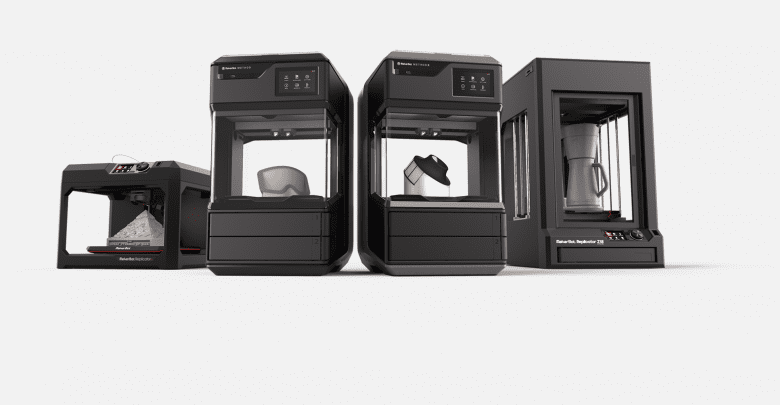MakerBot is launching METHOD X, a new manufacturing workstation engineered to challenge traditional manufacturing with real ABS (acrylonitrile butadiene styrene) material for durable parts, a 100°C chamber, and Stratasys SR-30 soluble supports. METHOD X can withstand up to 15°C higher temperatures, is up to 26% more rigid, and up to 12% stronger than modified ABS formulations used on desktop 3D printer competitors. MakerBot assures that Precision ABS parts printed on METHOD X have no warping or cracking that typically occurs when printing modified ABS on desktop platforms without heated chambers.
Most open desktop 3D printer manufacturers attempt to get around part deformation that occurs, due to the high shrinkage rate of the material, by using a heated build plate in combination with altered ABS formulations that are easier to print but compromise thermal and mechanical properties.
MakerBot Precision ABS has a heat deflection temperature of up to 15°C higher than competitors’ ABS, which are modified to make material printable without a heated chamber. This evaluation is based on MakerBot’s internal testing of injection-molded specimens of METHOD X ABS compared to ABS from a leading desktop 3D printer competitor. Tensile strength testing was performed according to ASTM D638 and HDT B testing according to ASTM D648.
In addition, with METHOD X, the 100°C Circulating Heated Chamber significantly reduces part deformation while increasing part durability and surface finish.
Stratasys expertise
MakerBot’s owner Stratasys’ experience combined with MakerBot’s accessibility and ease of use can thus provide professionals with an industrial 3D printer at a disruptive price point. MakerBot ABS for METHOD has excellent thermal and mechanical properties similar to ABS materials used for injection molding applications—making it ideal for a wide range of applications, including end-use parts, manufacturing tools, and functional prototypes.
A 100°C Circulating Heated Chamber provides a stable print environment for superior Z-layer bonding—resulting in high-strength parts with a superior surface finish. With the MakerBot METHOD X, engineers can design, test, and produce models and custom end-use parts with durable, production-grade ABS for their manufacturing needs.
Also new is the availability of Stratasys SR-30 material for easy and fast support removal. METHOD X is the only 3D printer in its price class that uses SR-30—enabling unlimited design freedom and the ability to print unrestricted geometries, such as large overhangs, cavities, and shelled parts. The combination of SR-30 and MakerBot ABS is designed to provide outstanding surface finish and print precision.
“When we initially launched METHOD, we broke the price-to-performance barrier by delivering a 3D printer that was designed to bridge the technology gap between industrial and desktop 3D printers. This made industrial 3D printing accessible to professionals for the first time. Since then, we have shipped hundreds of printers and received positive feedback from our customers on the precision and reliability of the machine,” said Nadav Goshen, CEO, MakerBot. “With METHOD X, we are taking a step further to revolutionize manufacturing. METHOD X was created for engineers who need true ABS for production-ready parts that are dimensionally-accurate with no geometric restrictions. METHOD X delivers industrial-level 3D printing without compromising on ABS material properties and automation in a new price category.”
Tinker-free method X
METHOD X also includes industrial features such as Dry-Sealed Material Bays, Dual Performance Extruders, Soluble Supports, and an Ultra-Rigid Metal Frame. METHOD X’s automation and industrial technologies create a controlled printing environment so professionals can design, test, and iterate faster. The lengthened thermal core in the performance extruders are up to 50% longer than a standard hot-end to enable faster extrusion. This results in up to 2X faster print speeds when compared to popular desktop 3D printers using the same layer height and infill density settings. The speed advantage is dependent upon object geometry and material as well.
These key technologies—combined with MakerBot ABS for METHOD—are designed to help engineers achieve dimensionally-accurate, production-grade parts at a significantly lower cost than traditional manufacturing processes. Engineers can print repeatable and consistent parts, such as jigs, fixtures, and end-effectors, with a measurable dimensional accuracy of ± 0.2mm (± 0.007in.), based on internal testing of selected geometries.
MakerBot METHOD X’s automated and advanced features provide users with a seamless workflow to help them optimize their design and production processes. The MakerBot METHOD X is one of the most intelligent 3D printers on the market, with 21 onboard sensors that help users monitor, enhance, and print their projects, including RFID chips, temperature sensing, humidity control, material detection, and more. The METHOD platform provides a seamless CAD to part workflow, with Solidworks, Autodesk Fusion 360 and Inventor plug-ins and support for over 30 types of CAD files, helping users turn their CAD files to parts quicker.
Source: 3dprintingmedia.network


